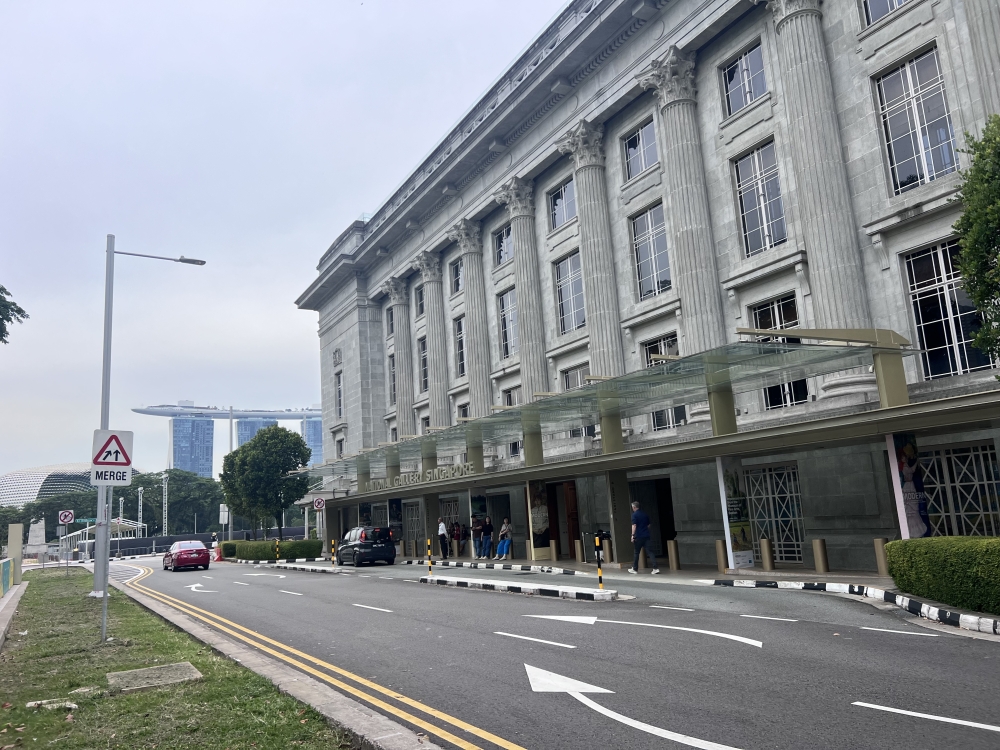SINGAPORE, Nov 11 — A woman walks slowly across a slightly tilted bridge that links two heritage buildings while her partner stands on another bridge above to take a top-down video.
This particular link bridge, already a perfectly Instagrammable spot since the National Gallery Singapore (NGS) opened its doors 10 years ago, became even more popular after it was featured in a music video Don’t Say You Love Me by K-pop idol Jin of BTS.
The bridge is much more than a link between two heritage buildings as it has become a symbol of how modern structures can easily blend in with heritage ones to create seamless experiences of the old and the new.
Since its establishment a decade ago, NGS has become the heart of art and culture in the civic district in Singapore and being housed within two national monuments—the former Supreme Court and City Hall—gives the exhibitions it hosts an additional layer of history.

The famous link bridge at the National Gallery Singapore. — Picture by Opalyn Mok
The former Supreme Court building was modelled after the Old Bailey in London and the foundation stone of the building was laid on April 1, 1937 with a time capsule cylinder underneath it.
The building, officially opened in 1939, used to have five courtrooms, a Court of Appeal, an impressive rotunda library and offices.
It was gazetted as a national monument in 1992 and the court was subsequently vacated in 2005.
This was when it was converted into the NAS along with the City Hall building next to it.
French firm Studio Milou Architecture won a design competition to convert the two heritage buildings into the NGS.

The foyer of the former Supreme Court building with the foundation stone. — Picture by Opalyn Mok
The original architecture of the court building featured intricate Corinthian sculpted columns by Italian artist Cavaliere Rodolfo Nolli and the building is topped by a distinctive rotunda, where the library is located and inside, the corridors are laid with Art Deco rubber tiles.
Next to it, the City Hall, formerly known as the Municipal Building, was just as impressive with a symmetrical layout and a front facade flanked by 18 three-storey high Corinthian columns.
Built in 1929, the City Hall witnessed important events such as the surrender of the Japanese and the swearing in of Singapore’s first Cabinet.
During construction works to convert these two heritage buildings into the NGS, a majority of the heritage features were preserved such as the Corinthian columns, the Art Deco styled rubber tiles that were replaced with marble tiles of similar designs, the windows and the City Hall steps, the carved furniture in the rotunda library, among many other features.
Particularly of note is the City Hall Chamber that was preserved as much as possible such as the Siena marble columns due to its importance in Singapore’s history, such as the signing of the Japanese forces surrender document in 1945 and the swearing-in of Singapore’s first Prime Minister Lee Kuan Yew on June 5, 1959.

The glass ceiling with water running across it to keep the interiors cool. — Picture by Opalyn Mok
To link the two buildings together, two bridges were built and to ensure the entire gallery is air-conditioned, glass ceilings were built to cover the space between both buildings.
Due to the tropical weather and the heat that resulted because of the glass ceilings, a special AI-activated water system to keep water flowing across the glass panels keeps the temperatures low.
Some of the features of the courtrooms in the former Supreme Court building were also kept, allowing visitors to marvel at the judge’s sitting area, the dock and in one of the courtrooms, the trapdoor leading to an underground tunnel was also maintained.
The tunnel leads directly to the lock-up in the basement and two of these lock-ups were maintained and though a major part of the tunnels have been covered, a short section was kept as an attraction for visitors who wish to try using the tunnel.

The ceilings of the former courtrooms and the visitors’ gallery were kept in its original condition. — Picture by Opalyn Mok
Banking on these extra features, the NGS have specialised tours for those who wish to visit the lock-up and the tunnel that still leads to a trapdoor that opens up into the dock of one of the courtrooms, now a converted gallery.
The NGS hosts a variety of exhibitions and shows with the largest South-east Asian art exhibition in the region featuring more than 300 artworks by artists in the region.
The buildings are also home to cafes, gift shops and restaurants.
Up on the Ng Teng Fong Roof Garden, there is now an ongoing installation by Tuan Andrew Nguyen titled “Temple” as part of the Singapore Biennale 2025.
It is an interactive installation that features bells, chimes and gong that have been tuned to emit frequencies believed to produce a healing effect on the body.
The NGS has daily guided tours and is open from 10am to 7pm. Find out more here.

